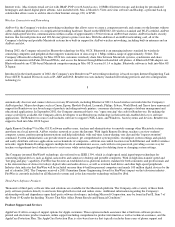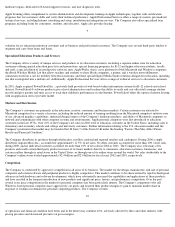Apple 2002 Annual Report Download - page 18
Download and view the complete annual report
Please find page 18 of the 2002 Apple annual report below. You can navigate through the pages in the report by either clicking on the pages listed below, or by using the keyword search tool below to find specific information within the annual report.
including demand forecasts, product lifecycle status, product development plans, and component cost trends. The personal computer industry is
subject to a rapid and unpredictable pace of product and component obsolescence. If future demand or market conditions for the Company's
products are less favorable than forecasted or if unforeseen technological changes negatively impact the utility of component inventory, the
Company may be required to record additional write-downs which would negatively affect gross margins in the period when the write-downs
are made.
The Company accrues necessary reserves for cancellation fees related to component orders that have been canceled. Consistent with industry
practice, the Company acquires components through a combination of formal purchase orders, supplier contracts, and open orders based on
projected demand information. These formal and informal commitments typically cover the Company's requirements for periods ranging from
30 to 130 days. If there is an abrupt and substantial decline in demand for one or more of the Company's products or an unanticipated change in
technological requirements for any of the Company's products, the Company may be required to record additional reserves for cancellation
fees, negatively affecting gross margins in the period when the cancellation fees are identified.
Valuation of Long-Lived Assets Including Acquired Intangibles
The Company reviews property, plant, and equipment and certain identifiable intangible assets for impairment whenever events or changes in
circumstances indicate the carrying amount of such an asset may not be recoverable. Recoverability of these assets is measured by comparison
of their carrying amount to future undiscounted cash flows the assets are expected to generate. If such assets are considered to be
20
impaired, the impairment to be recognized in earnings equals the amount by which the carrying value of the assets exceeds their fair market
value. Although the Company has recognized no material impairment adjustments related to its property, plant, and equipment or identifiable
intangibles during the past three fiscal years, except those made in conjunction with restructuring actions, deterioration in the Company's
business in a geographic region or business segment in the future, including deterioration in the performance of individual retail stores, could
lead to such impairment adjustments in the future periods in which such business issues are identified.
As of September 28, 2002, the Company had $85 million in goodwill. The Company adopted SFAS No. 142, Goodwill and Other Intangible
Assets
, in the first quarter of fiscal 2002. As a result, the Company no longer amortizes goodwill but instead performs a review of goodwill for
impairment annually, or earlier if indicators of potential impairment exist. The review of goodwill for potential impairment is highly subjective
and requires that: (1) goodwill be allocated to various business units of the Company's business to which it relates; (2) the Company estimate
the fair value of those business units to which the goodwill relates; and (3) the Company determine the book value of those business units. If
the estimated fair value of business units with allocated goodwill is determined to be less than their book value, the Company is required to
estimate the fair value of all identifiable assets and liabilities of those business units in a manner similar to a purchase price allocation for an
acquired business. This requires independent valuation of certain internally developed and unrecognized assets including in-process research
and development and developed technology. Once this process is complete, the amount of goodwill impairment, if any, can be determined.
Based on the Company's estimates as of September 28, 2002, there was no impairment of goodwill. However, changes in various
circumstances including changes in the Company's market capitalization, changes in the Company's forecasts, and changes in the Company's
internal business structure could cause one or more of the Company's business units to be valued differently thereby causing an impairment of
goodwill. Additionally, in response to changes in the personal computer industry and changes in global or regional economic conditions, the
Company may strategically realign its resources and consider restructuring, disposing of, or otherwise exiting businesses, which could result in
an impairment of property, plant, and equipment, identifiable intangibles, or goodwill.
Valuation of Non-Current Debt and Equity Investments
As of September 28, 2002, the Company held investments in certain debt and equity securities with a combined carrying value of $39 million.
These investments, which are reflected in the consolidated balance sheets as non-current debt and equity investments, have been categorized as
available-for-sale requiring that they be carried at fair value with unrealized gains and losses, net of taxes, reported in equity as a component of
accumulated other comprehensive income. The Company recognizes an impairment charge to earnings when it is judged an investment has
experienced a decline in value that is other-than-temporary. The Company has recognized material impairment charges related to its non-
current debt and equity investments in two quarters during the last two fiscal years. Various factors are considered in determining whether a
decline in value is other-than-temporary, including the length of time and extent to which the investment's market value has been less than its
cost basis, the financial condition and near-
term prospects of the issuer, and the Company's intent and ability to hold the investment for a period
of time sufficient to allow for any anticipated recovery in market value.
The Company's non-current debt and equity investments are in public companies whose security prices are subject to significant volatility. The
Company recognized a pre-tax impairment loss of $50 million related to two of these investments in the fourth quarter of 2002. As a result, as
of September 28, 2002, the Company had no significant unrealized gains or losses recorded against the carrying value of its non-current debt
and equity investments. Should the fair value of these investments fall below the Company's current cost bases and/or the financial condition or
prospects of either company deteriorate, the Company may determine in a future period that such a decline in fair value is other-than-
temporary,
























